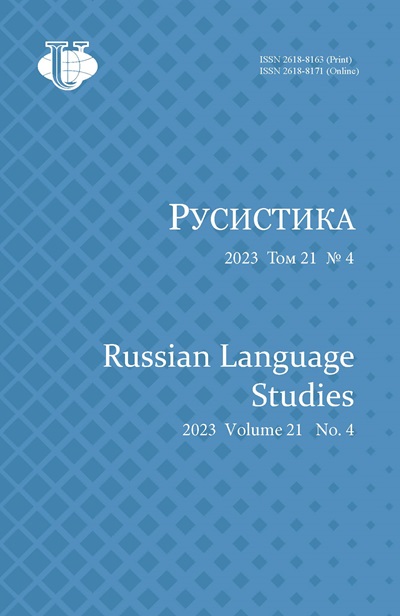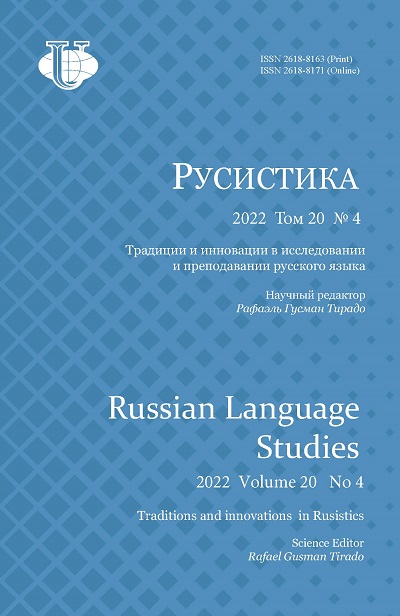Lexical innovations with the root popolam (‘in half’) in the Russian gendered Internet discourse
- Authors: Kallistratidis E.V.1, Ilyasova S.V.1
-
Affiliations:
- Southern Federal University
- Issue: Vol 20, No 4 (2022): Traditions and innovations in Rusistics
- Pages: 434-448
- Section: Key Issues of Russian Language Research
- URL: https://journals.rudn.ru/russian-language-studies/article/view/33141
- DOI: https://doi.org/10.22363/2618-8163-2022-20-4-434-448
Cite item
Full Text
Abstract
The relevance of the study is underpinned by the modifications of the Russian society gender canon, the Russian gender worldview transformations and by the growth of importance of the communicative and linguocultural Internet space that constitutes the field of spontaneous social, psychological and linguistic experiments and also representative sources of information on the Russian-speaking men and women’s speech practices. The research is aimed at revealing and describing derivational, semantic and functional features of the 23 lexicographically undefined, engendered lexical units motivated by the adverb popolam (‘in half’) pointing at the extralinguistic situation of the financial responsibility dividing ina couple. The research is conducted on the material of the authors' contexts corpus including 1750 speech products manifesting informal Internet communication that were published inthe period from 2012 to 2022. The corpus contexts were obtained by continuous sampling method with the help of the Russian social network VK search engine and Google web search engine. The authors used methods of word-formation, semantic interpretation, contextual and discursive analyses and statistical method. The analysis has diagnosed that the constituents of the derivational nest with popolam- as the basis are used to nominate, categorize, characterize and evaluate masculine and feminine persons as participants in romantic, sexual and family relations. The innovations are also used to denote and characterize relationships in a couple from the point of view of financial responsibility division between partners. They are also used to designate actions and behavior types of participants in such relationships. The analysis proves that the innovations contain stable negative evaluation and are prevalent in woman's language. The analysis revealed that the functions of denomination, categorization and negative evaluation of the social interaction subjects and phenomena depend on the main ideological function of the innovations. The ideological function is increasingly important underthe circumstances of the conflict between patriarchal and new egaliterian gender contacts. It is determined that popolamshchik (‘slammer’) as a male denomination is not only the most widespread and important constituent but also a key word of the gendered Internet discourse.
About the authors
Evgeniia V. Kallistratidis
Southern Federal University
Email: evakallas@sfedu.ru
ORCID iD: 0000-0003-2521-1026
Candidate of Philological Sciences, Associate Professor of the Department of the Russian Language for Foreign Students, Institution of Philology, Journalism and Intercultural Communication
105/42 Bolshaya Sadovaya St, Rostov-on-Don, 344006, Russian FederationSvetlana V. Ilyasova
Southern Federal University
Author for correspondence.
Email: ilyasova_rnd@mail.ru
ORCID iD: 0000-0003-2386-6512
Doctor of Philological Sciences, Professor, Professor of the Department of the Russian Language for Foreign Students, Institution of Philology, Journalism and Intercultural Communication
105/42 Bolshaya Sadovaya St, Rostov-on-Don, 344006, Russian FederationReferences
- Akalili, A., & Sari, I.O. (2021). Women and gender stereotyping in media from the point of view of structuration theory. Journal of Social Studies, 17(2), 165–178. https://doi.org/10.21831/jss.v17i2. 40326.165-178
- Álvarez, D., González, A., & Ubani, C. (2021). The portrayal of men and women in digital communication : Content analysis of gender roles and gender display in reaction GIFs. International Journal of Communication, (15), 462–292.
- Criezis, Μ. (2020). ‘Many Sisters Wish They Were Men’: Gendered discourse and themes in pro-ISIS Online Communities. Journal for Deradicalization, (25), 35–74.
- Danet, B. (1998). Text as mask : Gender and identity on the Internet. Cybersociety 2.0 : Revisiting Computer-Mediated Communication and Community (pp. 129–158). Thousand Oaks: Sage. https://doi.org/10.4135/9781452243689.n5
- Goodhew, S.C., Reynolds, K., Edwards, M., & Kidd, E. (2021). The content of gender stereotypes embedded in language use. Journal of Language and Social Psychology, 41(2), 219–231. 10.1177/0261927X211033930' target='_blank'>https://doi.org/doi: 10.1177/0261927X211033930
- Goroshko, E.I. (2008). Gender aspects of communication on the example of educational Internet prectices. Obrazovatel'nye Tekhnologii i Obshchestvo, 11(2), 388–411. (In Russ.)
- Graddol, D., & Swann, J. (1989). Gender voices. London : Basil Blackwell.
- Grigoryan, A.A., & Strelchuk, E. N. (2021). Russian diminutives on the social network Instagram[50]. RUDN Journal of Language Studies, Semiotics and Semantics, 12(4), 981–995. https://doi.org/10.22363/2313-2299-2021-12-4-981-995
- Ilyasova, S.V., & Pugacheva, E.V. (2021). Feminization of feminitives. Philology and Culture, (3), 12–17. (In Russ.) https://doi.org/10.26907/2074-0239-2021-65-3-12-17
- Kallistratidis, E.V. (2021a). Gender aspects of functioning of the neosemants nishchebrodand nishchebrodka in informal Internet communication. Modern Science : ActualProblems of Theory and Practise. Series : Humanities, (12), 132–137. (In Russ.) https://doi.org/10.37882/2223-2982.2021.12.09
- Kallistratidis, E.V. (2021b). Game transforms of usual designations of males as a means of representing the category of masculinity in informal Internet communication. Philolo-gical Sciences. The Questions of Theory and Practice, 14(10), 3034–3039. (In Russ.) https://doi.org/10.30853/phil210512
- Kareithi, P.J. (2014). Hegemonic masculinity in media contents. Media and Gender : A Scholarly Agenda for the Global Alliance on Media and Gender (pp. 26–29). Paris : CLD / UNESCO.
- Macharia, S., & Barata Mir, J. (2022). Gender equality and media regulation. Kalmar : Fojo, Linneaeus University.
- Radbil, T.B. (2021). Linguo-cultural and cognitive-discursive interpretation of active processes on the basis of foreign-language elements in the Russian language of Internet. The Russian language in the Internet communication : linguo-cognitive and pragmatic aspects : collective monography (pp. 10–92). Moscow: FLINTA. (In Russ.)
- Radbil, T.B., Ratsiburskaya, L.V., & Paloshi, I.V. (2021). Active processes in the vocabulary and word formation of the Russian language in the Era of Coronavirus : Linguo-cognitive aspect. Nauchnyi Dialog, (1), 63–79. (In Russ.) https://doi.org/10.24224/2227-1295-2021-1-63-79
- Sekerina, M.E., & Zacharova, U.G. (2017). Feminitives in the language of blogs. Gumanitarnye Nauchnye Issledovaniya, (4). (In Russ.) Available July 5, 2022, from http://human.snauka.ru/2017/04/23665
- Soltys, V.K. (2020). Gender issue in the Runet blogosphere language. Russian Language Studies, 18(4), 454–468. (In Russ.) http://doi.org/10.22363/2618-8163-2020-18-4-454-468
- Wilhelm, C. (2021). Gendered (in)visibility in digital media contexts. Studies in Communication Sciences, 21(1), 99–113. https://doi.org/10.24434/j.scoms.2021.01.007
- Yaniski-Ravid, S., & Mittelman, A. (2016). Gender biases in cyberspace : A two-stage model, the new arena of Wikipedia and other websites. Fordham Intellectual Property, Media and Entertainment Law Journal, XXVI(2)(B. 2), 381–416.
- Zdravomyslova, E.A., & Temkina, A.A. (2018). What is “masculinity”? Conceptual keys to critical studies in men and masculinities. Monitoring of Public Opinion : Economic and Social Changes, (6), 48–73. (In Russ.) https://doi.org/10.14515/monitoring.2018.6.03
- Ze, T.K., & Pannerselvam, I.B. (2021). Reinforcing or resisting? A study on the influence of Internet memes on sexism among university students in Penang. Journal of Contemporary Issues in Media and Communication, (1),1–31.















